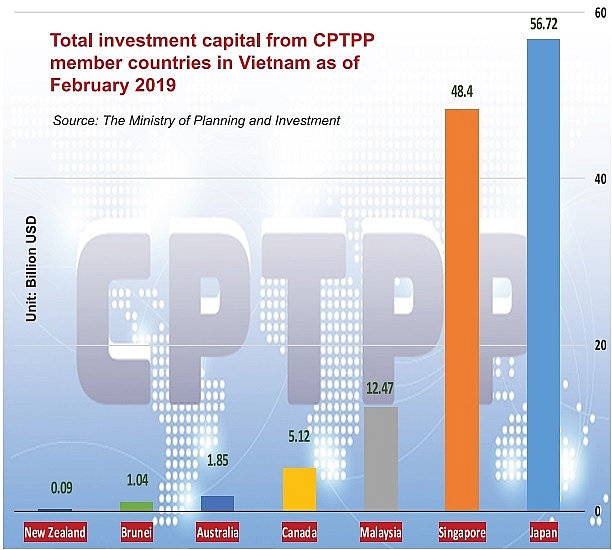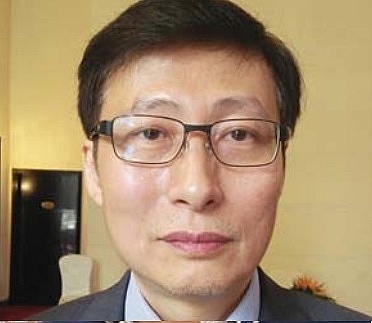CPTPP offers rising appeal
 |
Last week, a delegation from Singapore’s Sembcorp Industries worked with Vietnam’s southern province of Binh Duong, with the former’s president and CEO Neil MacGregor announcing that the group will invest in new projects with more added value, especially focussing on the application of hi-tech and renewable energy.
As a symbol of the two countries’ investment co-operation over the past 20 years, Sembcorp has so far invested in nine Vietnam-Singapore industrial parks, generating jobs for some 200,000 people. Sembcorp’s new commitment shows its strong interest in industrial property in Vietnam.
Boon across many sectors
Sembcorp is one of the success stories of Singaporean investment in the Vietnamese real estate market. Others include CapitaLand and Mapletree, both prominent names on the real estate market with plans to expand in Vietnam.
“Real estate and construction have traditionally been the big magnets drawing Singaporean businesses to Vietnam. It is forecast that the interest will continue in the future, driven by the newly-effective Comprehensive and Progressive Agreement for Trans-Pacific Partnership (CPTPP),” Jazreel Lim, president of the Singapore Business Association of Vietnam (SBAV), told VIR.
Evidently, real estate is among the most interesting sectors in Vietnam not only for Singaporean investors but also other CPTPP members, including those from South Korea, Japan, and Malaysia.
According to Viet Dragon Securities Corporation (VDSC), property is expected to get a big push from foreign investment inflows, driven by the growing demand for industrial parks, high-end buildings, resorts and golf-courses for entertainment, and offices for lease.
In this context, Vietnam’s appeal is said to mainly come from manufacturers exiting China for Vietnam and foreign direct investment (FDI) heading to Vietnam to serve the local and Southeast Asian markets.
Seeing the growth potential, Japanese investors are also venturing further into the sector. As shown in the recent survey by the Japan External Trade Organization (JETRO), the number of new Japanese-invested property and construction projects rose to 33 in 2018 from 19 in 2017. In terms of capital, fresh Japanese investment in real estate made up the largest proportion last year with $4.35 billion, making up 66 per cent of the country’s total. The figure in 2017 was $233 million or 3 per cent.
Currently, Japan’s Sumitomo and Vietnam’s BRG Group are co-operating to develop a $4.2 billion smart city project in Hanoi. Japan’s Mitsubishi has recently decided to pour about $500 million into many projects developed by domestic Phuc Khang Group, while Japanese Kajima Corporation is looking for opportunities in offices, residential areas, and other real estate development.
Businesses from Malaysia and New Zealand have also been joining the race. Malaysian names who have been on the local property market for years now include Gamuda Land, Berjaya, IJM Land, Guocoland, SP Setia, and Samling.
“The CPTPP has enhanced Vietnam’s position as an attractive location for investment. Vietnam’s growing economy offers numerous opportunities for prospective Malaysian investors,” said M. Zamruin Khalid, Malaysian Ambassador to Vietnam.
In addition to property, the CPTPP-driven competition is forecast to further stiffen in other sectors that can make great gains from the landmark agreement, including textiles and garments, fishery, logistics, agriculture, pharmaceuticals, and finance.
According to VDSC, Vietnam’s exports of textiles and garments to CPTPP member countries accounts for 13 per cent of the industry’s total export turnover, lower than the 38 per cent to the US. Among the 11 CPTPP member countries, Japan is the top importer of Vietnamese textiles and garments, at around $4.1 billion, or 8.8 per cent of the total.
One of the key contents of the CPTPP is the removal of 95-98 per cent of tariff lines as soon as the agreement enters into force. The remaining tariff lines will be cut over the next seven years, poised to aid the growth and export turnover of the two industries.
The fishery industry also shows bright prospects as the CPTPP member economies annually import about $2 billion, or 23 per cent of Vietnam’s total fishery export turnover. As expected, exporters of shrimp, octopus, and tuna will be the biggest winners.
Earlier this month, the Mekong Delta city of Can Tho granted an investment certificate for a seafood processing project to Japanese Marine Foods Corporation. Costing $14 million, the facility is expected to be put into operation in May 2020 with advanced technology and a focus on exports to Japan.
According to VDSC, logistics is also a potential industry for investors, with commodities via Vietnamese seaports forecast to grow by 8-9 per cent annually. In order to grab this potential, a group of Japanese and South Korean investors are seeking opportunities to invest in cold-chain logistics in the Mekong Delta region to meet the growing import-export demand.
Regarding pharmaceuticals, after the EU-Vietnam Free Trade Agreement (EVFTA) and the CPTPP come into effect, pharmaceutical imports and exports from the EU and other CPTPP countries will be duty free. “Consequently, foreign pharmaceutical companies would be able to import pharmaceutical products with lower taxation. The future plan for foreign-invested enterprises in the context of the CPTPP and other free trade agreements is to boost business from importation,” said Vaibhav Saxena, legal consultant at Vietnam International Law Firm.
Meanwhile, domestic Vietnamese businesses in agriculture, milk, sugarcane, animal feed, pharmacy, and finance will face more challenges amid the abundant higher-quality food supplies from Australia, New Zealand and others, thus urging them to change their approach to stand firm.
According to statistics from the Ministry of Health, Vietnam imported $3.7 billion worth of pharmaceuticals in 2018, up 8.8 per cent on-year. The figure is expected to rise further in the coming time. Among the 11 CPTPP member countries, Japan, Canada, and Mexico are among the top 20 manufacturers of pharmaceuticals worldwide.
In terms of banking and finance, Japan, Canada, and Australia can now sell financial services to Vietnam without establishing branches there, meaning more pressure in the local market.
Approaching higher-quality FDI
Industry insiders said that in this investment race, foreign investors can compete with their strong expertise in technology and make investments aligned with Vietnam’s new FDI strategy, giving priority to the five sectors of hi-tech/ICT, processing and manufacturing, supporting industries, tourism, and hi-tech agriculture.
Looking at the plans of CPTPP members, technology is one of their points of focus in Vietnam. For Japan, the main investments will continue to be in manufacturing, agriculture, logistics, healthcare, technology, banking and finance, and services, focusing on hi-technology.
Similar interests are also seen among Australian businesses in particular. Some are diversifying investment in Vietnam’s key sectors like manufacturing, education, services, logistics, and agriculture, with well-known names such as Telstra, BlueScope Steel, and VN Futuremilk.
At present, CPTPP member states make up 27.7 per cent of Vietnam’s total projects and 36.46 per cent of the total registered FDI. The country might expect higher-quality FDI inflows from members who can bring in high-technology, capital, and research and development (R&D) expertise that domestic businesses do not have, thus helping change the FDI picture in Vietnam towards bringing in higher added value to the economy, and increasing the competitiveness of its value chain.
For now, Vietnam’s new FDI attraction strategy is in the final stage of drafting before being submitted to the Politburo for approval. While clear-cut details are few and far between, not only Sembcorp from Singpore, but many other investors from the CPTPP members are expecting the new strategy to realise Vietnam’s high-quality FDI goal, thus further facilitating them in their future expansions.
| Sami Kteily - Executive chairman, PEB Steel
The CPTPP helps PEB Steel to expand into three new markets, namely Mexico, Canada, and Peru. Additionally, the CPTPP is aiding Vietnam in becoming a real manufacturing hub and a central part of the supply chain for many companies and products. Foreign investors will continue to pour money in, and expand their businesses in Vietnam. Meanwhile, some industries like seafood and agriculture will export semi-products or final products. Therefore, PEB Steel can benefit from this trend as all investors need factories and warehouses for manufacture. NGUYEN MINH CUONG - Principal country economist Asian Development Bank The CPTPP will bring significant benefits to Vietnam through the expansion of market access, and foreign direct investment. However, the CPTPP will also have to address multiple challenges, which include the development of effective regulatory frameworks for facilitation of trade, investment and intellectual property rights, and labour as well. More importantly, the CPTPP should be placed in a context when Vietnam is transforming from a low to high productivity economy, and from a low-middle income to high middle income country. it is more important for the country to capture value-addition of the CPTPP in terms of technology transfer and innovation. Anderson Tan - Chairman, SkillsSG Ventures Pte., Ltd. Singapore
The CPTPP is very beneficial to the skills development business. Direct benefits include more comprehensive intellectual property (IP) protection and more liberalised data-flow among CPTPP members, as well as access to local government training contracts. Firms deal mostly with IP and information products and services, and the CPTPP offers a good environment for businesses to flourish. Besides direct benefits, the reduction of behind-the-border regulatory barriers will be very useful to my business. Transparency and effective procedures are required in skills development. We allow for a quick clearance of skilled manpower and specialist imported training equipment from Singapore. Clear regulatory processes will encourage more confident investment from our stakeholders. A more open market landscape will increase competition from various CPTPP partners, but we believe such healthy international competition can only make SkillsSG Ventures and our stakeholders stronger. Raymond Mallon - Senior economic advisor, Australia-Vietnam economic reform programme
Under the CPTPP, Vietnam should consider unilaterally adopting economic reforms beneficial to the nation regardless of any trade and investment concessions from other countries. For example, reforming regulations to facilitate the development of competitive factor markets will be critical for both efficiency and equity objectives. Reforms to markets for agriculture land-use rights are needed to ensure farmers can benefit fairly from such rights. Reforms that simplify procedures and reduce administration costs are particularly important for small and medium-sized enterprises that often lack the resources needed to overcome bureaucratic hurdles. |
What the stars mean:
★ Poor ★ ★ Promising ★★★ Good ★★★★ Very good ★★★★★ Exceptional
 Tag:
Tag:
Themes: CPTPP
Related Contents
Latest News
More News
- Global partnerships key to Vietnam’s IFC development (December 26, 2025 | 16:18)
- Vingroup pulls out of bid to invest in North-South high-speed railway (December 26, 2025 | 11:42)
- Strengthening supply chains through trade promotions and customs reform (December 24, 2025 | 14:00)
- PM orders investment model for North–South high-speed rail (December 22, 2025 | 17:43)
- LS Eco Energy to invest in Vietnam rare earth sector (December 22, 2025 | 17:31)
- Government moves to establish International Financial Centre (December 21, 2025 | 21:00)
- Vietnam's IFC to target global investment flows (December 21, 2025 | 18:00)
- Two national hospitals expand capacity with new facilities (December 20, 2025 | 09:00)
- Ha Tinh breaks ground on major Vingroup industrial and energy projects (December 19, 2025 | 18:24)
- EVN launches major power infrastructure projects nationwide (December 19, 2025 | 18:17)

























 Mobile Version
Mobile Version